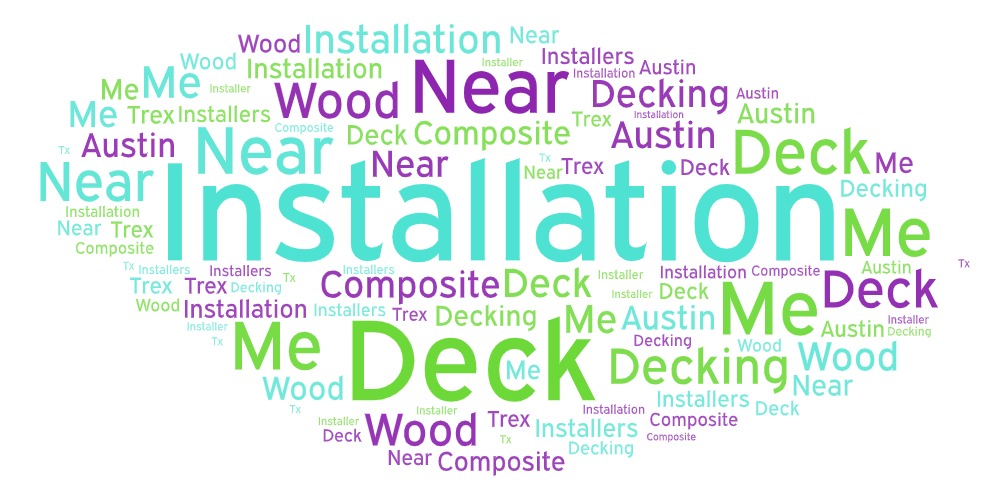

View Composite Deck Installation Austin TX in a full screen map
https://deckbuildersaustin.net/new-deck-installation/
| Entity | Definition |
|---|---|
| Trex Deck Builders | Contractors that specialize in building decks using Trex composite materials. |
| Trex Deck Builders Near Me | Local professionals skilled in installing Trex-brand decking systems with attention to detail. |
| Composite Deck Builders | Deck builders who focus on using composite materials that are weather-resistant and low maintenance. |
| Composite Deck Builders Near Me | Nearby services offering installation of composite decks tailored to your outdoor space. |
| Certified Trex Installers | Trained and certified professionals approved by Trex for high-quality decking installations. |
Austin Deck Builders – Built to Be Lived In
Your deck should be more than just a platform—it should be a space where life happens. Austin Deck Builders is here to create outdoor spaces that bring comfort, style, and usability together.
We offer professional deck installation in Austin with a focus on your vision. From natural wood to low-maintenance composite, from simple layouts to multi-level retreats—we build what works best for your lifestyle.
Our team believes in doing things right. That means proper planning, top-tier materials, and construction that can handle the ever-changing Texas weather.
Trust Austin Deck Builders to transform your backyard with craftsmanship that lasts. Contact us today to get started!
Austin, Texas, is known for its hot summers, mild winters, and relatively humid conditions. These weather patterns demand materials that can withstand intense sun exposure, occasional heavy rains, and temperature fluctuations. When building a deck in this region, it’s crucial to choose materials that are durable enough to handle the heat without warping or fading and resistant enough to repel mold and rot caused by humidity.
One of the most popular choices for deck installations in Austin is composite decking. Composite materials are made from a blend of wood fibers and plastic, which means they are highly resistant to the effects of weathering. They do not warp or splinter like traditional wood, nor do they require frequent staining or sealing. Their ability to mimic the look of real wood while offering superior durability makes them an excellent choice for enduring Austin's climate.
For those who prefer natural wood decks, hardwoods such as ipe (Brazilian walnut), teak, and cumaru offer inherent resistance to rot and insects—two common concerns in Austin’s humid environment. These woods have a tight grain structure that holds up well under intense sunlight and fluctuating temperatures. While they tend to be more expensive initially, their longevity can make them cost-effective over time with proper maintenance.
Pressure-treated lumber remains a viable option due to its treatment with chemicals that resist rotting and insect damage. It is also one of the more affordable materials available for deck construction in Austin. However, it does require regular maintenance such as staining or sealing to protect against moisture absorption and UV damage. For homeowners looking for a balance between cost-effectiveness and durability under harsh weather conditions, pressure-treated lumber can be an appropriate selection.
While less common than wood or composite options, metal decking made from aluminum or galvanized steel provides unmatched durability against Austin’s extreme temperatures. Metal decks won't crack or warp with changing climates; plus they're fireproof – an important consideration in areas prone to wildfires. They also reflect heat rather than absorbing it like other materials do; however this reflection might make them uncomfortably hot during peak summer months unless shaded properly or treated with special coatings designed specifically for comfort underfoot in direct sunlight.
After your wood deck is installed, it's essential to clean and seal it to protect the wood from moisture and weather damage. Wait for a dry period of weather, as applying sealant on damp wood can trap moisture inside. Start by sweeping the deck to remove debris. Use a deck cleaner to remove any dirt or stains. Once the deck is completely dry, apply a high-quality sealer with UV inhibitors, which will help prevent the wood from graying and deteriorating under sunlight.
To keep your deck looking its best, establish a regular cleaning routine. Sweep it weekly to prevent accumulation of leaves and other debris that could lead to mildew or staining. In case of spills, especially from greasy or acidic substances, clean them up immediately to avoid long-term damage. Annually, give your deck a thorough clean using a specialized wood cleaner and a brush with stiff bristles, but be careful not to use too much pressure that might splinter or damage the wood.
Moisture is one of the biggest enemies of wooden decks as it promotes mildew growth and can cause rot over time. Ensure that your deck has proper drainage and space for air circulation so that water does not pool on the surface or underneath. If you do notice signs of mildew, use a mildew-specific cleaner designed for wood decks to address these areas promptly before they spread.
Periodic inspections can catch small problems before they become big ones. Look for loose nails or screws, split or rotting boards, and any signs of structural weakness around posts and railings at least twice per year. Address these issues immediately—replacing hardware where necessary—to maintain safety and longevity.
While sealing right after installation is crucial, ongoing maintenance requires reapplication every few years depending on weather conditions in your area and how much direct sunlight your deck receives. A clear sign that it's time for another coat is when water no longer beads on the surface but instead soaks into the wood. Before resealing, always make sure you clean your deck thoroughly; this may also be an ideal time to consider restaining if you want to refresh or change the color while adding an extra layer of protection.
Despite regular maintenance efforts, accidents happen: boards may crack due to heavy weight or impact; discoloration can occur from furniture legs; scuffs appear through everyday use. When such damages arise, deal with them promptly—replace damaged boards entirely if needed—and touch up areas where stain or sealant may have worn away.
By following these maintenance steps diligently after installation, you'll extend the life span of your wood deck significantly while keeping it safe for enjoyment year-round.

Pros: durable, eco-friendly, low-maintenance. Cons: higher upfront cost, can get hot in summer. Long-term, it's cost-effective and attractive.
DIY is possible for basic decks, but hiring a pro ensures structural integrity, safety, permits, and a longer-lasting build.
Most companies offer free on-site or virtual estimates. Contact a local contractor online or by phone to schedule a consultation.
Yes especially in hot, humid climates like Austin. Though more expensive initially, it saves money over time on maintenance and replacement.